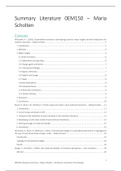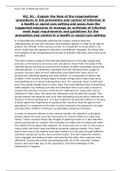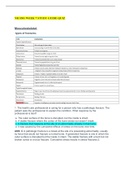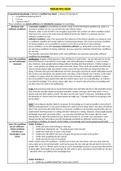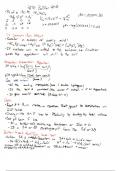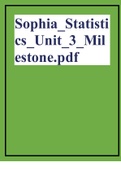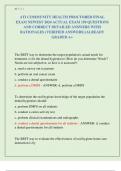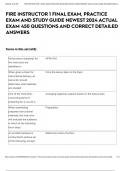Summary Literature 0EM150 – Maria
Scholten
Contents
Wieczorek, A. J. (2018). Sustainability transitions in developing countries: major insights and their implications for
research and policy – Global Context ........................................................................................................................... 5
1. Introduction ........................................................................................................................................................... 5
2. Methods ................................................................................................................................................................. 6
3. Major Insights ........................................................................................................................................................ 6
3.1 Niche Formation .............................................................................................................................................. 6
3.2 Experiments and upscaling ............................................................................................................................. 6
3.3 Change agents and factors .............................................................................................................................. 7
3.4 Transnational linkages ..................................................................................................................................... 7
3.5 Regime Uniformity........................................................................................................................................... 7
3.6 Stability and change ........................................................................................................................................ 8
3.7 Power ............................................................................................................................................................... 8
3.8 Path Dependence ............................................................................................................................................ 8
3.9 Contextual forces............................................................................................................................................. 8
3.10 Normative orientation................................................................................................................................... 9
3.11 System framing .............................................................................................................................................. 9
4. Discussion ............................................................................................................................................................... 9
5. Conclusions .......................................................................................................................................................... 10
Raven, R., Schot, J.W., Berkhout, F. (2012). Space and scale in socio-technical transitions. – Global Context ...... 11
1. Introduction ......................................................................................................................................................... 11
2. Current scales and levels in MLP ......................................................................................................................... 11
3. Critiques of the treatment of space and place in the transitions literature ..................................................... 12
4. Developing a multi-scalar model of socio-technical transitions........................................................................ 13
5. Working through an empirical example ............................................................................................................. 15
6. Conclusions .......................................................................................................................................................... 15
Wieczorek, A., Raven, R., Berkhout, F. (2015). Transnational linkages in sustainability experiments: A typology and
the case of solar photovoltaic energy in India. – Global Context .............................................................................. 16
Introduction ............................................................................................................................................................. 16
Typology of transnational linkages ......................................................................................................................... 16
Results ...................................................................................................................................................................... 18
Kanger, L., and Schot, J. (2016). User made immobilities: a transitions perspective. – User Innovation ............... 20
Abstract .................................................................................................................................................................... 20
1
0EM150 Literature Summary – Maria Scholten – Eindhoven University of Technology
, Introduction ............................................................................................................................................................. 20
Mobilizing transition studies ................................................................................................................................... 20
Automobile transition in the USA (1891-1964) ...................................................................................................... 22
Start-up (1891-1907) ........................................................................................................................................... 22
Acceleration (1908-1945) .................................................................................................................................... 22
Stabilization (1946-1964) .................................................................................................................................... 23
Discussion and conclusions: cross-fertilizing mobilities and transitions research ............................................... 24
Verbong, G. P. J., Wieczorek, A. J., & Verhees, B. (2019). The role of users in sustainable innovation. – User
Innovation..................................................................................................................................................................... 25
Introduction ............................................................................................................................................................. 25
The involvement of users in sustainable innovation .............................................................................................. 25
Passive vs. active ...................................................................................................................................................... 26
Enabling vs. constraining ......................................................................................................................................... 26
Individual vs. collective involvement ...................................................................................................................... 26
The role of users in sustainability transitions ......................................................................................................... 28
What is the added .................................................................................................................................................... 29
Discussion and research agenda ............................................................................................................................. 30
Goodpaster (2006). Conscience as a Mindset: Personal and Organizational (Chapter 3). – Sustainable
Entrepreneurship ......................................................................................................................................................... 32
Conscience in the Individual .................................................................................................................................... 32
Conscience as thoughtfulness ............................................................................................................................. 32
Conscience as awareness .................................................................................................................................... 32
Conscience as moral insight ................................................................................................................................ 32
The First and Second Polarities of Conscience ....................................................................................................... 32
Universal identification........................................................................................................................................ 33
Impartial generalization ...................................................................................................................................... 33
A third polarity – ideal to real.................................................................................................................................. 33
Summary of the three polarities ............................................................................................................................. 33
Corporate moral development: A typology ............................................................................................................ 33
Type 1 thinking: Conscience as a guide to self-interest .................................................................................... 34
Type 2 thinking: Conscience as a systemic constraint ....................................................................................... 34
Type 3 thinking: Conscience as an authoritative guide ..................................................................................... 34
The typology and stakeholders ............................................................................................................................... 34
Type 3 Organizations ............................................................................................................................................... 35
Corporate rationality: Messick and Bazerman ....................................................................................................... 35
Corporate respect: Varieties of Type 3 management ............................................................................................ 35
Interest-based avenues ....................................................................................................................................... 35
Rights-based avenues .......................................................................................................................................... 36
Duty-based avenues ............................................................................................................................................ 36
2
0EM150 Literature Summary – Maria Scholten – Eindhoven University of Technology
, Virtue-based avenues .......................................................................................................................................... 36
Combining rationality and respect...................................................................................................................... 37
Conclusion ................................................................................................................................................................ 38
McMahon, Ch. (1981). Morality and the Invisible Hand. – Sustainable Entrepreneurship ..................................... 39
I ................................................................................................................................................................................. 39
II ................................................................................................................................................................................ 39
III ............................................................................................................................................................................... 41
IV ............................................................................................................................................................................... 41
V ................................................................................................................................................................................ 41
Slides Erik Laes regarding McMahon ...................................................................................................................... 42
Fung, A. (2006) "Varieties of participation in complex governance." – Policy and Participation ............................ 43
Participatory Designs: The Democracy Cube.......................................................................................................... 43
Participant selection ................................................................................................................................................ 44
Communication and Decision ................................................................................................................................. 44
Authority and Power ................................................................................................................................................ 45
The Democracy Cube........................................................................................................................................... 46
Legitimacy................................................................................................................................................................. 46
Justice ....................................................................................................................................................................... 47
Effectiveness ............................................................................................................................................................ 47
Conclusion ................................................................................................................................................................ 48
Stilgoe, J., Owen, R. & Macnaghten, P. (2013) Developing a framework for responsible innovation. – Policy and
Participation ................................................................................................................................................................. 49
1. Introduction ......................................................................................................................................................... 49
1.1 Responsibility, science and innovation ......................................................................................................... 49
1.2 A new scientific governance? ....................................................................................................................... 49
2. Four Dimensions of Responsible Innovation ...................................................................................................... 50
2.1 Anticipation .................................................................................................................................................... 50
2.2 Reflexivity ....................................................................................................................................................... 50
2.3 Inclusion ......................................................................................................................................................... 51
2.4 Responsiveness .............................................................................................................................................. 51
2.5 Integrating the Dimensions of Responsible Innovation .............................................................................. 52
3. Responsible Innovation in Action: A Case Study of ‘Technoscience in the Making’ ........................................ 52
3.1 Socio-political context for the case study .................................................................................................... 53
3.2 The SPICE Project: History ............................................................................................................................. 53
3.3 Embedding the Dimensions of Responsible Innovation within SPICE ........................................................ 53
3.4 Reflections on the SPICE Project ................................................................................................................... 53
4. Discussion ............................................................................................................................................................. 54
Garud, Hardy & Maguire (2007). Institutional Entrepreneurship as Embedded Agency: An Introduction to the
Special Issue. – Institutional Entrepreneurship .......................................................................................................... 55
3
0EM150 Literature Summary – Maria Scholten – Eindhoven University of Technology
, Institutions................................................................................................................................................................ 55
Entrepreneurship ..................................................................................................................................................... 55
Institutions and Entrepreneurship .......................................................................................................................... 56
The Paradox of Embedded Agency ......................................................................................................................... 56
Swyngedouw (2005). Governance Innovation and the Citizen: The Janus Face of Governance-beyond-the-State. –
Institutional Entrepreneurship .................................................................................................................................... 57
1. Introduction: Towards Governance-beyond-the-State ..................................................................................... 57
2. Governance-beyond-the-State: Networked Associations ................................................................................. 57
3. Articulating State, Market and Civil Society ....................................................................................................... 58
4. The Democratic Deficit of Governance-beyond-the-State ................................................................................ 59
4.1 Entitlement and Status .................................................................................................................................. 60
4.2 The Structure of Representation .................................................................................................................. 60
4.3 Accountability ................................................................................................................................................ 60
4.4 Legitimacy ...................................................................................................................................................... 60
4.5 Scales of Governance .................................................................................................................................... 60
4.6 Orders of Governance ................................................................................................................................... 61
5. The Janus Face of Governance-beyond-the-State: The Contradictions of Social Innovation in Governance 61
4
0EM150 Literature Summary – Maria Scholten – Eindhoven University of Technology
, Wieczorek, A. J. (2018). Sustainability transitions in developing
countries: major insights and their implications for research and
policy – Global Context
1. Introduction
Sustainability transitions literature is a rapidly growing and influential field of research. It builds on the argument
that the interconnected, complex and global character of current challenges such as climate change or growing
social inequalities, requires a radical change in the basic systems. Such change is described by the term transition,
whereas the systems are conceptualized as socio-technical. Socio-technical implies that every aspect of life, from
technology, institutions, economy to the socio-cultural sphere, must transform for a system change to be
effective.
Policymakers are interested in transitions because incremental, technical changes based on end-of-pipe solutions,
cleaner products or eco-efficiency, are not believed to lead to sustainability.
The most fundamental model to explain the unfolding of transitions is the Multilevel Perspective on system
innovation (MLP). MLP distinguishes three levels. The central level comprises of socio-technical regimes: sets of
rules and routines that define the dominant 'way of doing things’. Regimes are stabilized by the socio-technical
landscape. Landscape encompasses such processes as urbanization, demographic changes, wars or crises that can
put pressure on the regimes making them vulnerable to more radical changes. Regimes transform on condition
of availability of alternatives that can fulfil the same societal function. Alternatives are developed in niches,
protected spaces, that facilitate experimentation with novelties.
In the context of MLP, system transformation is driven by change agents and occurs in the outcome of mutually
reinforcing contextual, landscape pressures, internal regime destabilization processes and upscaling of
innovations developed in niches (see Figure 1).
Figure 1: A multilevel perspective on system innovation.
Strategic Niche Management (SNM) argues for shielding, networking, learning and alignment of expectations as
preconditions of construction, empowerment and upscaling of niches. Transition Management (TM) perspective
focusses on influencing, coordinating and bringing together (niche) actors and their activities in such way that
together, they can accelerate the change towards sustainability.
5
0EM150 Literature Summary – Maria Scholten – Eindhoven University of Technology

